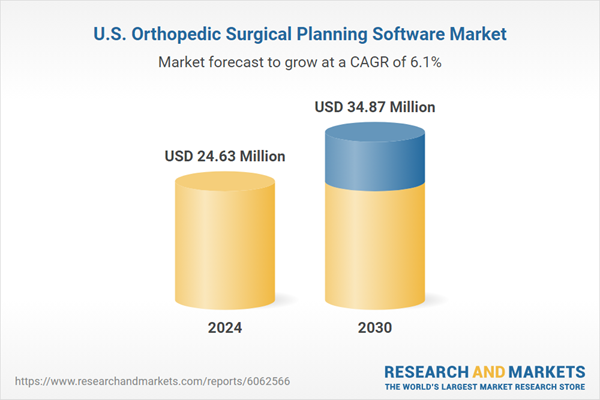As the global population ages, there is a substantial rise in the prevalence of age-related orthopedic conditions, such as osteoarthritis, degenerative joint diseases, fractures, and osteoporosis. As per the WHO report, by the year 2030, one in every six individuals globally will be 60 years or older. At that time, the percentage of the population aged 60 and up will rise from 1 billion in 2020 to 1.4 billion. By the year 2050, the global population of those aged 60 years and above will be twice as large, reaching 2.1 billion. This demographic is particularly vulnerable to orthopedic conditions due to the natural degeneration of bones and joints over time, along with decreased mobility and muscle mass. Thus, such factors are anticipated to fuel market growth over the forecast period.
Furthermore, minimally invasive surgeries have gained attention in orthopedics for their benefits, including smaller incisions, less tissue trauma, and faster recovery times. Common procedures include arthroscopy, endoscopic spinal surgeries, and minimally invasive joint replacements. These techniques necessitate thorough preoperative and postoperative planning because of their complexity. Orthopedic surgical planning software plays a crucial role by providing detailed 3D visualizations, real-time simulations, and precise measurements. This technology helps surgeons navigate complex anatomical structures effectively, contributing to the accelerated growth of the market.
Furthermore, market players are opting for various strategic initiatives expected to boost the growth of the market in the country. Medtronic has launched new AI-driven preoperative planning tools tailored for orthopedic surgeries, responding to the increasing demand for advanced technologies in the field. This initiative reflects a broader trend of integrating artificial intelligence into surgical planning processes to enhance precision and outcomes. In addition, in June 2024, Zimmer Biomet formed a strategic partnership with a healthcare software provider to develop AI-powered preoperative planning tools aimed at improving precision in orthopedic surgeries. Such collaborations emphasize the commitment of major players to innovate and enhance surgical planning technologies.
U.S. Orthopedic Surgical Planning Software Market Report Highlights
- Based on software delivery, the cloud-based segment held the largest revenue share in 2024, owing to rising technological advancements, and a shortage of skilled professionals to operate and manage this software in healthcare facilities.
- Based on software type, the pre-operative segment dominated the market with revenue share in 2024, due to growing awareness regarding the benefits associated with the use of pre-operative surgical planning software.
- Based on end use, the orthopedic clinics owing to patients' increasing preference for surgery in orthopedic clinics and the increasing number of orthopedic clinics globally.
Why should you buy this report?
- Comprehensive Market Analysis: Gain detailed insights into the global market across major regions and segments.
- Competitive Landscape: Explore the market presence of key players worldwide.
- Future Trends: Discover the pivotal trends and drivers shaping the future of the global market.
- Actionable Recommendations: Utilize insights to uncover new revenue streams and guide strategic business decisions.
This Report Addresses:
- Market intelligence to enable effective decision-making
- Market estimates and forecasts from 2018 to 2030
- Growth opportunities and trend analyses
- Segment and regional revenue forecasts for market assessment
- Competition strategy and market share analysis
- Product innovation listing for you to stay ahead of the curve
- COVID-19's impact and how to sustain in these fast-evolving markets
This product will be delivered within 2 business days.
Table of Contents
Companies Mentioned
- Stryker
- Radlink, Inc.
- Zimmer Biomet
- DePuy Synthes (Johnson & Johnson Medical Devices Companies)
- Enhatch Inc.
- Brainlab AG
- Corin Group
- EOS imaging (ATEC Spine Inc.)
- Formus Labs Ltd
- mediCAD
Methodology

LOADING...
Table Information
| Report Attribute | Details |
|---|---|
| No. of Pages | 150 |
| Published | March 2025 |
| Forecast Period | 2024 - 2030 |
| Estimated Market Value ( USD | $ 24.63 Million |
| Forecasted Market Value ( USD | $ 34.87 Million |
| Compound Annual Growth Rate | 6.0% |
| Regions Covered | United States |
| No. of Companies Mentioned | 10 |









